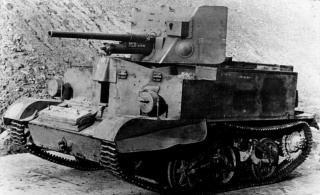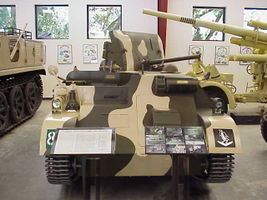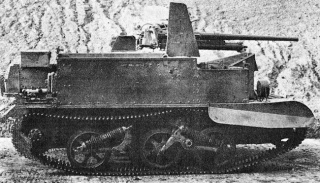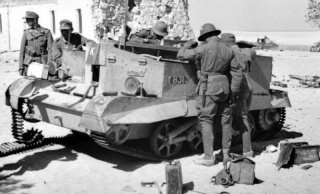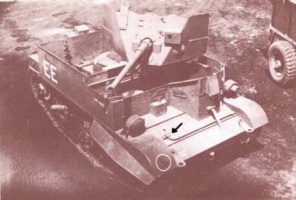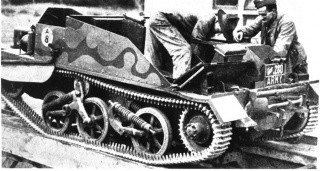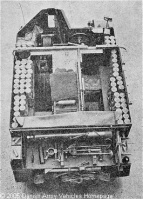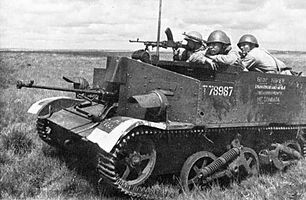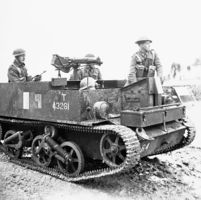Universal Carrier 2-pdr
GB39_Universal_CarrierQF2 (Stock)
| 3900 Cost |
| 230 HPDurability |
| 4.52 / 7 Weight |
- Commander
- Radio Operator
- Gunner
- Driver
- Loader
| 10/7/7Hull Armor(front/sides/rear, mm) |
| 5/5/0Turret Armor(front/sides/rear, mm) |
| 100 h.p.Engine Power |
| 48 km/hTop Speed / Reverse Speed |
| 44 deg/sTraverse Speed |
| 45 |
| 64 mmAverage Penetration |
| 3.5 Gun Loading |
| 26 deg/sGun Traverse Speed |
| 230 mView Range |
| 500 mSignal Range |
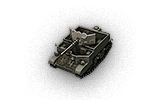

Gun
| Level | Gun | Average Penetration (mm) | Rate of Fire | Dispersion at 100 m | Aiming Time | Experience | Weight (t) | |
|---|---|---|---|---|---|---|---|---|
| II | QF 2-pdr AT Gun Mk. IX | 64/121/12 | 45/45/60 | 17.14 | 0.36 | 2.3 | 0 | 130 |
| II | QF 6-pdr 8 cwt AT Gun Mk. II | 45/57/15 | 90/90/120 | 9.45 | 0.48 | 2.3 | 310 | 300 |
| IV | QF 6-pdr 8 cwt AT Gun Mk. I | 57/72/15 | 90/90/120 | 9.57 | 0.45 | 2.3 | 2160 | 450 |

Engine
| Level | Engine | Engine Power (h.p.) | Chance of Fire on Impact | Experience | Weight (t) |
|---|---|---|---|---|---|
| I | Ford V8-239 | 100 | 20 | 0 | 258 |

| Level | Suspension | Load Limit | Traverse Speed (deg/s) | Experience | Weight (t) |
|---|---|---|---|---|---|
| I | Universal Carrier Mk. I | 7 | 44 | 0 | 1500 |

Radio
| Level | Radio | Signal Range (m) | Experience | Weight (t) |
|---|---|---|---|---|
| II | N14 | 500 | 0 | 40 |
Compatible Equipment
Compatible Consumables
Player Opinion
Pros and Cons
Pros:
- Powerful gun selection
- Fairly fast
- Very stealthy
- Small target
Cons:
- Non-existent armor
- Low HP pool
- Big HE target
Performance
This little Tier 2 powerhouse TD is the first in the British AT line. Though it is a far cry from the later tanks in terms of armor, it has a powerful selection of guns. The UC has a fairly easy stock grind, as the 2 Pounder is a capable gun, but the first 6 Pounder is inaccurate and has a long aiming time. It is best to use the 2-pounder until unlocking the second 6-pounder, which is unbelievably powerful.
This machine is best used from a concealed position or in a support role. It can be penetrated easily by HE shells, even from Tier 1 guns. By utilizing the stealth and agility of this TD, you can become a top player in any battle.
Historical Info
The Carrier, Anti-tank, 2-pdr, or Carrier 2-pdr Tank Attack was a heavily modified and lengthened LP2 carrier with a fully traversable QF 2 pounder anti-tank gun mounted on a platform at the rear and the engine moved to the front left of the vehicle. Stowage was provided for 112 rounds of 2-pounder ammunition. 200 were produced and used for training.
Development history
The origins of the Universal Carrier family can be traced back generally to the Carden Loyd tankettes family which was developed in the 1920s, and specifically the Mk VI tankette. In 1934 Vickers Armstrong produced, as a commercial venture, a light tracked vehicle that could be used either to carry a machine gun or to tow a light field gun. The VA.D50 had an armoured box at the front for driver and a gunner and bench seating at the back for the gun crew. It was considered by the War Office as a possible replacement for their "Dragon" artillery tractors and took 69 as the "Light Dragon Mark III". One was built as the "Carrier, Machine-Gun Experimental (Armoured)" carrying a machine gun and its crew. The decision was made to drop the machine gun and its team and the next design had a crew of three – driver and gunner in the front, third crew-member on the left in the rear and the right rear open for stowage. A small number of this design as "Carrier, Machine-Gun No 1 Mark 1" were built and entered service in 1936. Some were converted into pilot models for the Machine gun Carrier, Cavalry Carrier and Scout Carrier – the others were used for training.
The carrier put the driver and commander at the front sitting side-by-side; the driver to the right. The engine was in the centre of the vehicle with the final drive at the rear. The suspension was a mixture of the Vickers light tank and Horstmann springs Directional control was through a (vertical) steering wheel. Small turns moved the front road wheel assembly warping the track so the vehicle drifted to that side. Further movement of the wheel braked the appropriate track to give a turn. The hull in front of the commander's position jutted forward to give room for the Bren gun (or another armament) to fire through a simple slit. To either side of the engine were two areas in which passengers could ride or stores be carried. Initially, there were several different types of Carrier that varied slightly in design according to their purpose: "Medium Machine Gun Carrier" (the Vickers machine gun), "Bren Gun Carrier", "Scout Carrier" and "Cavalry Carrier". However, production of a single model came to be preferred and the Universal design appeared in 1940; this was the most widely produced of the Carriers. It differed from the previous models in having a rectangular body shape in rear section, with more space for crew.
Production history
Production of Carriers began in 1934 and it ended in 1960. Before the Universal design was introduced, the vehicles were produced by Aveling and Porter, Bedford Vehicles, the British branch of the Ford Motor Company, Morris Motors Limited, the Sentinel Waggon Works, and the Thornycroft company. With the introduction of the Universal, production in the UK was undertaken by Aveling-Barford, Ford, Sentinel, Thornycroft, and Wolseley Motors. By 1945 production amounted to approximately 57,000 of all models, including some 2,400 early ones. The Ford Motor Company of Canada manufactured about 29,000 of the Universal Carriers. Smaller numbers of them were also produced in Australia (about 5,000), where hulls were made in several places in Victoria and by South Australian Railways workshops in Adelaide, South Australia. About 1,300 were also produced in New Zealand.
Combat history
The Reconnaissance Corps regiments – which replaced the cavalry regiments in supporting Infantry divisions after 1940 – were each equipped with 63 carriers along with 28 Humber Scout cars. Universal Carriers were issued to the Support companies in infantry rifle battalions for carrying support weapons (initially 10, 21 by 1941, and up to 33 per battalion by 1943). A British armoured division of 1940–41 had 109 carriers in total; each motor battalion had 44. Artillery units used them as an artillery tractor for the Ordnance QF 6 pounder anti-tank gun. The British Carrier Platoon originally had ten Universal Carriers with three Carrier Sections of three Universal Carriers each plus another Universal Carrier in the platoon HQ. Each Universal Carrier had an NCO, a rifleman, and a driver/mechanic. One Universal Carrier in each section was commanded by a sergeant and the other two by corporals.
All the Universal Carriers were armed with a Bren light machine gun and one Carrier in each Carrier Section also had a Boys anti-tank rifle. By 1941 the Carrier platoon increased in strength to contain four Carrier sections and one Carrier in the Carrier sections also carried a 2-inch mortar. By 1943 each Universal Carrier now had a crew of four, an NCO, driver/mechanic and two riflemen. The Boys anti-tank rifle was also replaced by the PIAT anti-tank weapon. The Universal Carrier's weapons could be fired from in or outside of the Carrier. A Carrier platoon had a higher number of light support weapons than a rifle company.
The Carrier, Anti-tank, 2-pdr, or Carrier 2-pdr Tank Attack was a heavily modified and lengthened LP2 carrier with a fully traversable QF 2 pounder anti-tank gun mounted on a platform at the rear and the engine moved to the front left of the vehicle. Stowage was provided for 112 rounds of 2pdr ammunition. 200 were produced and used for training.
Historical Gallery
| Light Tanks | IICruiser Mk. III • IIICruiser Mk. IV • IVCovenanter • VCrusader |
| Medium Tanks | IVickers Medium Mk. I • IIVickers Medium Mk. II • IIIVickers Medium Mk. III • IVMatilda • IVAC 1 Sentinel • VMatilda Black Prince • VICromwell • VIIComet • VIIICenturion Mk. I • IXCenturion Mk. 7/1 • XFV4202 |
| Heavy Tanks | VChurchill I • VExcelsior • VIChurchill VII • VITOG II* • VIIBlack Prince • VIIICaernarvon • IXConqueror • XFV215b |
| Tank Destroyers | IIUniversal Carrier 2-pdr • IIIValentine AT • IVAlecto • VAngry Connor • VAT 2 • VIChurchill Gun Carrier • VIAT 8 • VIIAT 15A • VIIAT 7 • VIIIAT 15 • IXTortoise • XFV215b (183) |
| USA | IIT18 • IIIT82 • IVM8A1 • IVT40 • VM10 Wolverine • VT49 • VIM18 Hellcat • VIM36 Jackson • VIIT25/2 • VIIT25 AT • VIIIT28 • VIIIT28 Prototype • IXT30 • IXT95 • XT110E3 • XT110E4 |
| UK | IIUniversal Carrier 2-pdr • IIIValentine AT • IVAlecto • VAngry Connor • VAT 2 • VIChurchill Gun Carrier • VIAT 8 • VIIAT 15A • VIIAT 7 • VIIIAT 15 • IXTortoise • XFV215b (183) |
| Germany | IIPanzerjäger I • IIIMarder II • IVHetzer • VStuG III Ausf. G • VIDicker Max • VIJagdpanzer IV • VIIE 25 • VIIE 25 "#1" • VIIJagdpanther • VIIIFerdinand • VIIIJagdpanther II • VIII8,8 cm Pak 43 Jagdtiger • VIIISnowstorm Jagdtiger 8.8 • IXJagdtiger • XJagdpanzer E 100 |
| USSR | IIAT-1 • IIISU-76 • IVSU-85B • VSU-85 • VSU-85I • VISU-100 • VISU-100Y • VIISU-152 • VIISU-100M1 • VIISU-122-44 • VIIIISU-152 • VIIISU-101 • IXObject 704 • IXSU-122-54 • XObject 263 • XObject 268 |
| France | |
| China | |
| Japan | |
| Czechoslovakia | |
| Sweden |
